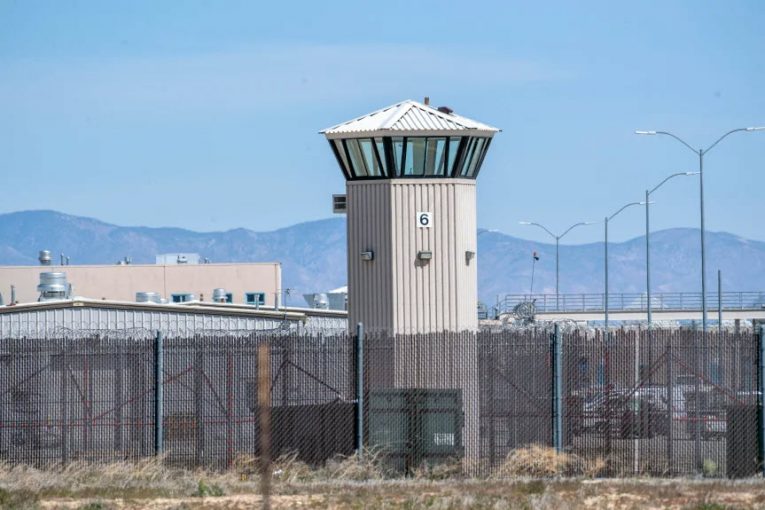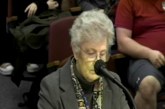
By Julietta Bisharyan and Nick Gardner
Incarcerated Narratives
SAN QUENTIN – Accounts from an incarcerated individual at San Quentin State Prison unveils the unsanitary and unsafe living conditions inside as the prison continues to recover from its major COVID-19 outbreak.
Through a series of letters, incarcerated comic book artist and illustrative journalist Orlando Smith shared his experiences with the Davis Vanguard, writing from inside San Quentin’s 168-year-old prison.
In a previous article, published by the Davis Vanguard, Smith described the filthy conditions he and other incarcerated people were subject to. At the time, San Quentin had over 200 active cases. Since then, the number of active cases reported by CDCR have decreased to just one –– a sharp decline since reaching its peak of 1,635 cases on Jul. 7.
“I still feel at risk,” Smith, 53, says. “The conditions have not changed.”
Smith says that there are a lot more active cases among the incarcerated population than what is being reported by CDCR, revealing that most who become infected with the virus choose to stay quarantined in their cells rather than alerting medical staff.
“This prison system’s only directive is to use any and all tools as punitive measures,” says Smith.
Individuals who report their symptoms are moved around and often placed in tents with no heat. Most were infected before officials started testing, so symptoms cleared up before testing began.
As for the living conditions, Smith says that he refuses to eat any state made food, describing the kitchen in San Quentin as “filthy” and with a rodent infestation. The prison population continues to be on lockdown status 24/7, now for over 18 weeks, with only two hours a week outside their cells.
Incarcerated persons are given two bars of soap a week and one and a half hours for showering, yard time and/or phone use. With enforced double-celling, frequent transfers and poor ventilation, it is nearly impossible to social distance, as recommended by the CDC.
“We have all these nurses and doctors coming in and out, and no one seems to speak out about this,” Smith adds.
Smith also notes that San Quentin still lacks in cleaning supplies and only gets disinfected every two and a half weeks, minus any deep scrubbing.
In regard to mask wear, incarcerated persons are given masks but not on a regular basis. Outside their cells, mask wearing is hardly enforced. A few guards even refuse to wear masks while at work, or at the very least, while inside the building.
Smith also believes that prison officials are formulating “herd immunity” –– a form of indirect protection from infectious disease when a sufficient percentage of a population becomes immune to an infection ––– to show that numbers have gone down to keep from mass releases.
In addition, he maintains that the prison outbreaks are being downplayed in court, particularly in Marin County, as CDCR continues to insist that conditions have improved and that individuals are being kept safe.
As of Oct. 16, there is only one active case at San Quentin, according to CDCR. 2,152 cases have been resolved, 58 have been released while active and 28 individuals have died from complications related to COVID-19.
“The numbers from CDCR tell only half the story,” Smith concludes. “As of right now, the incarcerated people, in a sense, are nothing more than a remote, unfortunate abstract.”
CDCR Confirmed COVID-19 Cases and Outcomes
As of Oct. 16, there are a total of 15,274 confirmed COVID-19 cases in the CDCR system – 514 of them emerged in the last two weeks. 3.6% of the cases are active in custody while 3% have been released while active. Roughly 93% of confirmed cases have been resolved.
There have been 70 deaths within the CDCR facilities. 27 incarcerated persons are currently receiving medical care at outside health care facilities across the state.
On Oct. 14, an incarcerated person from Folsom State Prison (FSP) died at an outside hospital from what appears to be complications related to COVID-19. This is the second incarcerated person from FSP to be identified as a COVID-related death.
CDCR did not identify the individual for medical privacy reasons.
FSP currently has 24 incarcerated persons who are actively positive for COVID-19. This week, the prison only reported nine new cases while resolving 62 cases.
In an email response to The Sacramento Bee, regarding the situation at FSP, CDCR said efforts to mitigate the spread of COVID-19 at all of its institutions include “mandatory bi-monthly testing of staff, weekly testing of staff where an outbreak is being reported, continuing to require the use of facial barriers for staff and the population, enforcing physical distancing directives, providing appropriate personal protective equipment to staff and the population, identifying isolation and quarantine space, conducting contact tracing for both staff and incarcerated population COVID-19 cases, and regular testing of the incarcerated population.”
Last week, Pelican Bay State Prison (PBSP) reported its first COVID-19 case among its incarcerated population. The following day, the number went back down to zero. According to Public Information Officer Terry Thornton, the case that showed up on CDCR’s Tracking page was the result of a recurring data error from June.
On Wednesday, Deuel Vocational Institute (DVI) resolved their only listed confirmed case. The institution’s cumulative confirmed case number is once again back down to zero.
Valley State Prison (VSP) has tested the most patients in the last two weeks –– 79% of its population. Pelican Bay State Prison (PBSP) has tested the least during this period, only 4% of its population.
There are currently 92,468 incarcerated persons in California’s prisons – a reduction of 21,850 since Mar. 12, 2020, when the prison outbreaks first began.
Effect on the Public
The Fresno Police Department is reacting to a spike in crime that they believe to have stemmed from early coronavirus related policies.
According to Fresno Chief of Police Andy Hall, the 126% increase in shootings and 55% increase in murders is the byproduct of a zero-bail policy dating back to early April. The policy was originally intended to prevent overcrowding in jails, where close living quarters and poor ventilation create an optimal environment for the deadly virus to spread rapidly.
During the height of the pandemic, Fresno County Jail saw a massive outbreak of COVID-19 infecting over 600 individuals. As of late, the jail has reported just 3 positive cases, with hundreds of inmates still under quarantine.
Zero-dollar bail, coupled with CDCR’s inability to accept incarcerated individuals from all but two county jails, has facilitated an unprecedented number of early releases.
In the eyes of the Fresno Police Department, these newly released individuals are fueling the spike in crime.
The Fresno PD thus vowed to implement a targeted, data-based operation to remove violent criminals from the streets. Just three days into the operation, law enforcement officers had made 43 felony arrests, 38 of which were known gang members.
Currently, talks between Judge Alvin Harrel, Sheriff Margaret Mims, and Chief Hall are being held to discuss the zero-dollar bail emergency order, its impacts, and possible adjustments.
——
Despite early signs of a historic wildfire season, California is moving forward with the closure of eight incarcerated fire camps.
Each year, incarcerated individuals from these camps are deployed to the front lines of the state’s wildfires. Tasks performed by incarcerated firefighters include making fire cuts, clearing up brush, and constructing containment lines.
However, as thousands of inmates are released in an attempt to limit the spread of COVID-19 within state prisons, these camps have seen a steep decline in participants. This year, the population of California’s fire camps is down to 1,800 individuals— less than half of what it was in 2016.
As a result, eight of these 43 camps will shut down operations.
Cal Fire is responding to the decrease in crews, according to Assistant Deputy Director Daniel Berlant.
“We definitely don’t want to see a panic in the closures. This has been a trend that we’ve been watching for a number of years and we have been planning for the change-out of inmates to other types of crews,” Berlant told Fox 40 News.
Berlant pointed to measures already underway, such as Governor Gavin Newsom’s authorization of 850 seasonal firefighters to replace released inmates as well as the CDCR’s formation of crews with parolees.
However, Berlant recognizes that the historic wildfire season facing California will need to be fought with more resources.
“With significant fire activity this year we definitely are continuing that conversation and looking to ensure we have the appropriate amount of resources to respond,” Berlant said.
According to a CDCR representative, incarcerated individuals from the closed camps will be relocated to other camps across the state.
The camps are set to close by the end of 2020. Affected camps include:
Northern Region
- Chamberlain Creek Conservation Camp, Fort Bragg, CA (Mendocino County)
- Devil’s Garden Conservation Camp, Alturas, CA (Modoc County)
- High Rock Conservation Camp, Weott, CA (Humboldt County)
- Valley View Conservation Camp, Elk Creek, CA (Glenn County)
Southern Region
- Baseline Conservation Camp, Jamestown, CA (Tuolumne County)
- McCain Valley Conservation Camp, Boulevard, CA (San Diego County)
- Pilot Rock Conservation Camp, Crestline, CA (San Bernardino County)
- Rainbow Conservation Camp, Fallbrook, CA (San Diego County)
*Courtesy of Fox 40 News
CDCR Staff
There have been at least 3,934 cases of COVID-19 reported among prison staff. 10 staff members have died while 2,983 have returned to work. 951 are still active.
CDCR Comparisons – California and the US
According to the Marshall Project, California prisons rank fourth in the country for the highest number of confirmed cases, following Texas, Florida and Federal prisons. California makes up 10.3% of total cases among incarcerated people and 5.6% of the total deaths in prison.
California also makes up 12% of total cases and 11.6% of total deaths among prison staff.
Division of Juvenile Justice
As of Oct. 16, there are no active cases of COVID-19 among youth at DJJ facilities. 68 cases have been resolved.




